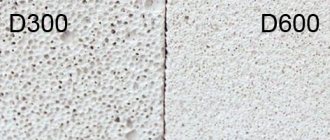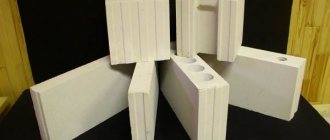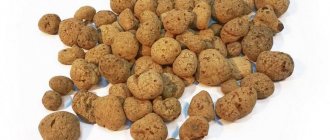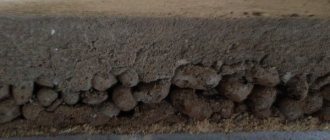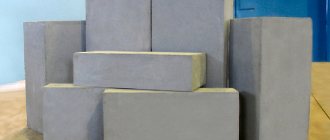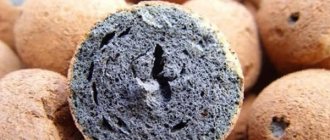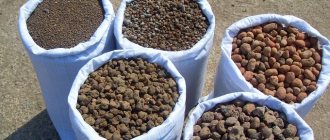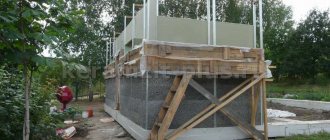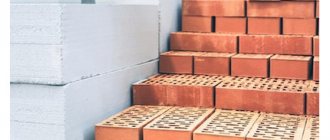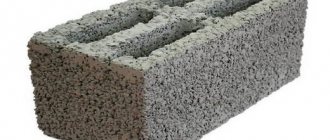The most important criterion when choosing building materials used for the construction and arrangement of any structure is thermal conductivity. As its value decreases, the temperature in the rooms increases and the cost of heating them decreases. The best thermal insulation characteristics are inherent in materials that have a closed-cell structure. Expanded clay is often used in construction, the high popularity of which is also due to its relatively low weight, excellent soundproofing properties, and affordable price.
According to reference data, the thermal conductivity coefficient of this material is 0.1 – 0.18 W/(m*K). The value of this indicator is influenced by a combination of factors, the main of which are:
- humidity;
- granule size;
- bulk density, layer thickness.
To eliminate the dependence of the thermal conductivity of expanded clay on the presence of moisture, you should take care of waterproofing the floor in advance.
Expanded clay as insulation
Classifying such insulation according to the method of production and the size of the granules, there are several of its varieties:
- gravel;
- crushed stone;
- sand.
The first is rounded grains 2-4 cm in size, having a porous structure, covered with a durable shell. It is the presence of closed cells containing air that makes it possible to use expanded clay gravel as insulation. It is obtained by swelling light grades of clay. This fraction is characterized by the best thermal insulation properties.
Expanded clay crushed stone is a product of crushing expanded soft clay into fractions 1-2 cm in size. As a result, elements are formed that have an irregular, often angular shape. If the insulation contains only grains of this type, then the thermal conductivity of expanded clay will be slightly higher.
The by-product formed during the production of two main fractions is expanded clay sand, which is grains 0.5-1 cm in size. It has worse thermal insulation properties compared to gravel and crushed stone. This variety is used mainly as a porous filler included in the concrete screed.
Influence of bulk density and layer thickness on overall thermal conductivity
Provided that equal thermal insulation properties are achieved, the layer of expanded clay gravel will have a smaller thickness compared to crushed stone. The load on the floor in the first case is lower - this is due to the difference in bulk density. This parameter characterizes the ratio of the total mass of granules (in this case, expanded clay) to their total volume, without taking into account the spaces between them and the inevitable chips that occur.
The density of expanded clay takes values from 250 to 800 kg/m3.
In practice, a mixture of three fractions is used as insulation: gravel, crushed stone, sand. In this way, the greatest rigidity and the smallest layer thickness are achieved, and the convection movement of heated air through the resulting voids between the granules is also prevented. Therefore, when calculating the height of the expanded clay layer, it would be more correct to be guided by the value of the true density, which is 1.5-2 times higher than the bulk density. Its recommended thickness when laying on the ground is 25-30 cm. When insulating a concrete floor, it should not be less than 10 cm.
Comparison with mineral wool and polystyrene foam
Polystyrene foam has good insulating properties, which are expressed by a specific value - 0.047 W/(m*K). It is widely used for finishing apartments or private houses, office buildings. But, despite the seemingly greater efficiency of the foam board (relative to the expanded clay layer), this is not always the case.
Where it is necessary to equip surfaces that are subject to frequent mechanical stress and significant loads, it is better to use a mixture of gravel and crushed stone. However, when insulating walls and attic floors, foam plastic will be more effective. In addition, it is lightweight and characterized by a smaller thickness compared to other insulation materials. All this allows it to be used where excessive loads on the floor are unacceptable.
When insulating with foam plastic, additional waterproofing is not required. However, like most polymeric materials, it is inherently flammable.
Mineral wool is also widely used to protect homes from cold weather. But even in this case, you should not compare the thermal conductivity of mineral wool and expanded clay, even though its value in the first case is much lower (0.048-0.07 W/(m*K)). Such insulation materials are used in different cases. So, for cladding walls and ceilings in private houses on the inside of the room, neither gravel, nor crushed stone, nor, especially, expanded clay sand are absolutely suitable. Mineral wool will be practically irreplaceable here.
However, it is a rather voluminous insulating material. Any attempts to compress it will lead to a decrease in the volume of air contained in the mineral wool, and therefore to a decrease in efficiency. In addition, mineral wool should be used extremely carefully. This type of insulation has a negative effect on the human body. This characteristic suggests that all installation work should be carried out only with the use of personal protective equipment.
The efficiency of a heating system largely depends on the insulation used to insulate walls and ceilings. Expanded clay or mineral wool are evaluated in terms of practicality, cost, and performance characteristics.
Thermal conductivity is not the only indicator used to evaluate the merits of thermal insulation materials. The thermal conductivity coefficient of mineral wool is about 0.04 W/(m*K), and expanded clay is 0.1-0.18 W/(m*K). During operation, this indicator is influenced by the scope of application, the thickness of the insulation layer, and the level of humidity.
The practicality of mineral wool and expanded clay granules is assessed according to a number of parameters:
| Characteristics | Expanded clay | Minvata |
| Thermal conductivity | 0.18 W/(m*K) | 0.048 W/(m*K) |
| Layer thickness | 950 mm | 253 mm |
| Condensation Formation | No | Yes - vapor barrier required |
| 475 kg/m² | 10.1 kg/m² | |
| Environmental friendliness | Clay is a natural material | Phenolic resins are used in the production of mineral wool. |
| Fire safety | Incombustible | When exposed to direct fire, the adhesive binder burns, releasing phenol |
| Biostability | Resistant to fungi and mold. Not a habitat for insects and rodents |
To insulate a horizontal surface, mineral wool or expanded clay can be used. The vertical backfill will settle over time, pushing the walls apart. Moisture-resistant expanded clay granules are considered the best insulation for basements, basements and bathrooms. Lightweight cotton insulation is carefully insulated from residential premises to eliminate health hazards.
If installation rules are followed, manufacturers of both types of insulation guarantee a service life of more than 50 years.
Description of expanded clay
Expanded clay is no exception . Its production is based on the principle of heating light clay at a high melting point. A kind of boiling and swelling of the material occurs. If you stop heating at this time and quickly remove the heat, clay balls with a porous structure will form. Next comes firing in the same way as when making clay bricks. That's it, the expanded clay is ready .
Simple technology and a large number of deposits of the necessary clay have made this material popular for insulating buildings and structures.
Types of expanded clay
An important characteristic for builders will be the shape of expanded clay:
- Gravel in the form of rounded pebbles. The main type used.
- Crushed stone, irregularly shaped granules. It is obtained by crushing coarse gravel.
- Sand, a derivative when producing gravel and crushed stone.
For expanded clay gravel and crushed stone, there are divisions by size into fractions:
- Small up to 10 mm.
- Medium, between 10 and 20 mm.
- Large no more than 40 mm.
Larger stones are crushed, and those less than 5 mm are ground into sand.
Specifications
more complex characteristics are also used , for example:
- Thermal conductivity. Defined as a certain coefficient for a conditionally homogeneous material.
- Bulk density. It is important to know when choosing the thickness of the bulk cushion how the load on the foundation increases.
- Compaction factor. Mainly used during transportation to determine the possible height of the embankment.
- With a reduced coefficient, there is a possibility that the material will begin to absorb moisture and exhibit its hygroscopicity and water absorption, and this will significantly change its thermal insulation property.
- Soundproofing. Typically, expanded clay has this property at a high level.
- Fire resistance. The indicator is close to absolute, the clay simply does not burn.
- Frost resistance. The indicator is closely related to the ability to absorb water and can be affected by high humidity.
- Chemical resistance. The material is practically not susceptible to chemical attack and can withstand any impact.
- Biological stability. It is enough that the fungus does not grow there and rodents do not make nests.
Use in construction
In addition to using expanded clay as insulation in the form of bulk material, it is used in the manufacture of various construction products:
- For the production of lightweight concrete, the use of ceramic gravel instead of granite significantly reduces thermal conductivity. Of course, this reduces its strength, but it remains sufficient for the construction of low-rise buildings.
- Reinforced concrete slabs with expanded clay filler are important in the construction of multi-story buildings. The design of the building usually does not provide for the load on the external walls, but the thermal conductivity coefficient plays an important role.
- Lightweight hollow expanded clay blocks and bricks have always been popular among the population. Low price, lightweight, easy to install, they are simply ideal for individual construction. The main thing is to comply with the requirement - to insulate well from moisture.
Which is cheaper: comparison of the cost of two materials
1 cubic meter of expanded clay gravel can be bought for 1,500 rubles, 1 roll of mineral wool measuring 8200x1220x50 mm costs from 1,400 rubles.
The cost estimate for insulation should include costs for:
- for the services of loaders - for the delivery of heavy bags of expanded clay;
- additional consumables - timber, vapor barrier membrane, fasteners;
- personal protective equipment - important when using mineral wool insulation.
To simultaneously solve the problems of thermal insulation and sound insulation, it is clear that mineral wool is better. Expanded clay is not an insulation material, and the low cost of the material can be completely offset by the need to use it in large quantities.
Reviews about expanded clay
Alexander, 42 years old, Volgograd: “I used expanded clay to screed the floor in the bathroom and toilet. Waterproofing “Osnovit”, 7 cm layer filled with cement laitance, cement-sand screed and tiles on top. It’s normal, it’s warm.”
Alexey, 38 years old, Saratov: “I covered the ceiling of the attic of an old house with expanded clay with a layer of 20 cm. It became warmer, and the rain was less audible.”
As you know, complete insulation of a private house is simply physically impossible without insulating the ceiling: it is from there that the strongest wind pressure “blows”, cold air comes in in winter and too hot air in summer. For example, if you insulate the walls and do not do the same with the ceiling, all the work will go down the drain, since it will give absolutely no effect (all the heat will simply go “to the ceiling”).
What is better to choose?
Expanded clay and mineral wool have similar characteristics of heat and sound protection, but differ in different environmental safety. If you want to completely eliminate any harmful effects of the material on your home and outbuildings, choose expanded clay insulation.
As you know, complete insulation of a private house is simply physically impossible without insulating the ceiling: it is from there that the strongest wind pressure “blows”, cold air comes in in winter and too hot air in summer. For example, if you insulate the walls and do not do the same with the ceiling, all the work will go down the drain, since it will give absolutely no effect (all the heat will simply go “to the ceiling”).
Main types of insulation and their characteristics
Today you can buy dozens of types of insulation on the market.
- mineral wool;
- Styrofoam;
- expanded clay;
- sawdust.
Advantages of mineral wool:
Mineral wool also has its disadvantages:
The cheapest of all types of ceiling insulation is, of course, the well-known polystyrene foam (and outbuildings are most often insulated with clay). Despite its cheapness and visually apparent fragility, this material is still worth considering as insulation: it has some important positive characteristics.
It is also important to add that expanded polystyrene (this is the official name for foam in the construction industry) is often used in conjunction with other thermal insulation materials (especially when it comes to ceilings - not only in the house, but also in the garage).
Polystyrene foam is one of the cheapest materials
The advantages of polystyrene foam as insulation include the following:
- this material is completely indifferent to moisture and can be used indoors with extremely high humidity levels (up to 99%);
- mold cannot a priori form in it (and on it), since the material is completely resistant to fungi of various origins;
- cheapness (a ton of polystyrene foam does not even cost $100 - this amount is enough for the entire palace of Scheherizade, and not just for an ordinary house, roof, attic or roof);
- lightness (virtually does not bear additional load on the floors and foundation of the building);
- long service life;
- can withstand severe temperature changes (from -65C° to +50C°), which makes it possible to use it both in the Far North and in the southern regions of Russia.
Of course, polystyrene foam also has its disadvantages:
- minimal mechanical strength (the smallest force is enough to pierce the foam or deform it - everyone knows this for sure from infancy);
- expanded polystyrene has an air permeability coefficient of 10% - this is negligible (the material practically does not allow air to pass through - the room will be cool in winter and quite hot in the warm season, and this is not entirely good);
- easily destroyed under the influence of furniture varnish and paints made on the basis of nitroglycerin (modern facade paints contain large quantities of it, with the exception of oil and epoxy paints).
In general, we can conclude that polystyrene foam is an extremely cheap material that is easy to install with your own hands, but it is still not an effective insulation material (especially for houses made of foam blocks).
It is suitable for a temporary home (dacha, for example), but for a permanent home it is better not to use it (technology often simply does not allow it).
Table with characteristics of some types of insulation
Among the advantages of this material are an extremely low thermal conductivity coefficient, ease of installation, high sound insulation and noise-absorbing properties. By the way, noise and sound are completely different things, although many do not understand this (and yet manufacturers of building materials classify them differently).
Expanded clay is divided into several types, depending on the size of the fractions
Expanded clay also has disadvantages: a porous structure and extreme fragility (a particle of expanded clay can be crushed into powder by literally pressing the little fingers of both hands).
The process of insulating the ceiling with expanded clay
Sawdust has been used as insulation for a very long time. Strictly speaking, they have only 2 main advantages: low cost and good thermal insulation properties. In simple terms, we can say the following: insulating the ceiling with sawdust is a more correct solution when compared with expanded clay, but in terms of its technical qualities it is noticeably inferior to polystyrene foam and mineral wool. Sawdust cannot be used just like that, out of the blue, under no circumstances.
They must meet the following criteria:
How to insulate a house with expanded clay
Ecology of consumption. Estate: Experts tell how to properly use expanded clay as an effective insulation.
The modern construction market offers many ways to insulate a private home. Can expanded clay compete with modern insulation materials? how and where it is better to use expanded clay as insulation; is there any economic benefit from using this material? To answer these questions, let’s turn to the experience of experts and consider this material in detail.
What is expanded clay
Expanded clay is a porous granular material of low weight. For the production of expanded clay, low-melting clay is usually used. It is rapidly heated to 1000-1300°C for 25-40 minutes in a thermal chamber. During this process, the raw material “boils” and “swells.” Due to this, voids appear, when they harden, pores are formed in the expanded clay granules, enclosed in a shell of clay.
Expanded clay is an environmentally friendly and durable material that is widely used in construction.
The scope of expanded clay directly depends on its density and the size of the crushed stone fraction. Namely:
- 0-5 – so-called expanded clay sand;
- 5-10;
- 10-20;
- 20-40.
The brand of expanded clay (depending on its bulk density) can vary from 200 to 800 kg/m3.
The most popular brands of expanded clay:
- M350
- M600
The higher the density of expanded clay, the stronger it is, and the worse its thermal insulation qualities as insulation. In addition to density and thermal conductivity, you need to pay attention to the water absorption of expanded clay. This indicator largely determines the durability of expanded clay and possible areas of its application. Simply put, is the material afraid of water or not, i.e. how much moisture will expanded clay absorb (as a percentage of its dry weight) placed in a moisture-saturated environment. On average, the water absorption of expanded clay (depending on the production technology) ranges from 8 to 20%.
How to choose and use expanded clay
Most often, expanded clay is used as bulk insulation for thermal insulation of floors, interfloor excavations, external walls in the so-called. well masonry.
Three-layer well masonry is when a layer of expanded clay is poured between the internal main load-bearing wall (for example, made of foam or aerated concrete) and the external decorative brickwork. Expanded clay is also used as a filler in the production of lightweight concrete.
Anyone who is planning to build a house from foam blocks will find it useful to read the article, which talks about the features and principles of choosing foam concrete.
Despite the fact that expanded clay has been used in construction for a long time, there are many different conjectures and rumors about its properties and methods of use. Some builders scold this material, believing that it is subject to strong moisture accumulation. Others consider it ideal for a do-it-yourself developer.
From experience:
The following experiment came up naturally - I had expanded clay in bags standing on my street for two years. Recently I opened the bags and saw that there was nothing left of the expanded clay - the balls had turned into damp dust.
Any building material, be it expanded clay, brick, foam and aerated concrete, etc. If used incorrectly, installed, stored and operated, it will lose its quality.
From experience:
I think I just came across “undercooked” expanded clay. I once had to collect expanded clay that had been lying on the ground for 30-40 years. The granules were even overgrown with moss. I sifted the expanded clay from the ground; there were more whole granules than fragments.
The properties of expanded clay directly depend on the quality of the raw materials and careful compliance with all stages of production. Hence: from different manufacturers, expanded clay of the same fraction and density may differ from each other.
Therefore, you can buy both a “pig in a poke” and a high-quality product, which, if used correctly, will show all its positive properties.
To choose expanded clay, you first need to decide for what purpose it is needed and what it will be used for insulation.
From experience:
I need expanded clay as insulation for walls and as a filler for lightweight concrete. So I was wondering which expanded clay to choose, which fraction?
There is an opinion that it is better to take fractions 5-10 or 10-20 as a filler for lightweight concrete, because The higher the bulk strength, the higher the grade of expanded clay concrete.
The specific brand is selected depending on the requirements for the wall material. Also, the user of our portal advises to study reviews on the Internet about the supplier company before purchasing expanded clay. It happens that careless sellers mix dirt into bags of expanded clay or weigh down buyers.
How to choose the right expanded clay? To get a comprehensive answer from experienced builders, you need to clarify in which region of the Russian Federation the construction is planned, what kind of house is being built, according to what project. This will help you understand why and where expanded clay will be used.
A general rule that is useful to everyone: the characteristics of the product (density, brand, frost resistance, etc.) must correspond to the declared technical parameters, which can be found on the manufacturer’s website. When delivering, they should bring “honest” cubes, not “air”. It is worth paying attention to whether you buy expanded clay from intermediaries who inflate the price, or directly from the manufacturer, how long the manufacturer has been on the market, what equipment he has. Therefore, it is worth listening to the opinions of those who have already built it and looking for a manufacturer that has proven itself well.
Is insulation with expanded clay beneficial?
When choosing expanded clay as wall or floor insulation, you need to immediately calculate the economic feasibility of this idea. Why? It's all about the thermal conductivity of expanded clay.
Consider the following examples:
From experience: Depending on the density, the thermal conductivity coefficient (lambda) of expanded clay varies from 0.11 to 0.23 W/(m*°C). With a density of expanded clay of 400 kg/m3, its thermal conductivity coefficient will be 0.15 W/(m*°C). Insulation thickness 0.15/0.15 W/(m*°C) = heat transfer resistance R=1. Next: 1*0.05 W/(m*°C) (thermal conductivity coefficient (lambda) of PPS polystyrene foam) = 0.05 m.
Hence: according to the thermal characteristics, 15 cm of expanded clay with a density of 400 kg/m3 corresponds to 5 cm of expanded polystyrene grade PSB-25.
If you take and compare expanded clay/stone wool, then the comparisons will again not be in favor of expanded clay. If we take average values (the average thermal conductivity coefficient of expanded clay depending on its density is 0.1-0.14 W/(m*°C), and stone wool is 0.04 W/(m*°C), then in order to obtain a comparable thermal protection effect, Expanded clay will require about 12 cm versus 5 cm of stone wool.It turns out that you will have to increase the thickness of the expanded clay layer.
From experience:
I thought about using expanded clay instead of extruded polystyrene foam in the foundation of the USP.
After calculations, it is clear that such a replacement is unlikely to be justified. The fact is that although expanded clay is about three times cheaper than EPS, its thermal conductivity is five times (or even higher) higher. Therefore, you will have to lay a layer of expanded clay of at least 0.5 m, and in combination with a warm floor system - 0.7-0.8 m.
It turns out that although the price for 1 cubic. m of expanded clay is less than the cost of 1 cubic meter. m EPS, but due to the increase in the bedding layer, expanded clay will be required 4-5 times more. Those. the price of a layer of equivalent insulation with expanded clay will be 2-2.5 times more expensive than EPS, which will negate all the benefits of its use.
If we are talking about a wooden house, then in order to insulate it with expanded clay, you will have to build a strong foundation (since expanded clay weighs more than stone wool), think about how to fill the expanded clay so that the granules do not spill out, etc. . You won't be able to save money either.
Note: because the cost of insulation in different regions can vary significantly; the final price is calculated based on local characteristics and the availability of certain materials.
Therefore, each specific case of insulating a house with expanded clay requires a separate calculation based on the climate zone, the degree of heat loss of the house, the duration of the heating season and the price of insulation materials.
However, there are examples of how to competently approach insulating a house with expanded clay and still win.
From experience:
I have a house 8x8 meters, built of aerated concrete with a density of D600, block sizes 625x300x200. I spent a long time choosing how to insulate the cottage. After going through several insulation materials, I settled on expanded clay as an environmentally friendly and relatively inexpensive material.
Intersen approach to the implementation of home insulation. Place of construction - Kirov region. The walls of the house are made in the form of three-layer masonry. Expanded clay 15 cm thick is poured between aerated concrete and the external masonry of sand-lime brick. Expanded clay is poured with cement laitance. Heated area – 50 sq. m. The second floor is closed. The house is heated by three electric convectors with a total power of 4 kW. Food is cooked on an electric stove, + there are 2 water heaters in the house with a total capacity of 150 liters. Total: heating costs for December amounted to 1.5 thousand rubles. at a tariff of 2 rubles. 7 kopecks for 1 kW*hour. The cost of insulating a house with expanded clay, including delivery and labor, is about 77 thousand rubles.
Insulated blind area made of expanded clay
Builders who use expanded clay are familiar with the expression that expanded clay does not work in the ground. That is, below the ground level (especially moisture-saturated soils and high groundwater levels), expanded clay has nothing to do. If you neglect this rule, expanded clay will “drink” water and lose all its positive properties.
The more interesting is the method in which expanded clay can be used as a replacement for extruded polystyrene foam in the construction of an insulated blind area.
From experience:
Expanded clay was used in the blind area as a remedy against frost. Expanded clay of the M450 brand, fraction 5-20, was used. The fragility of this material is very conditional. You need to buy high-quality material, follow the installation technology, and all problems will be solved.
The essence of the method, successfully tested by a forum member, is as follows. Because “burying” expanded clay in the ground is a futile task; in order for it to “work”, it must be isolated from the influence of the external environment, i.e. – waterproof. Which is what was done. The blind area pie (if we consider the layers from bottom to top) is like this:
- priming;
- coarse sand, mechanically compacted;
- expanded clay, “wrapped” in a 2x20 m profiled drainage membrane;
- geogrid;
- crushed stone
The width of the expanded clay backfill is 1.2 m, the layer thickness is about 15-20 cm.
In the video, the owners of a house in the forest tell why they chose expanded clay concrete as a wall material.
published econet.ru
PS And remember, just by changing your consumption, we are changing the world together! © econet
Join us on Facebook, VKontakte, Odnoklassniki
Methods for installing insulation
Insulation from above (from the attic)
External insulation of the ceiling (in the absence of a concrete balcony) is a more preferable option, since it is simply easier to install from the attic area. Some people prefer to insulate the ceiling both from the attic and from the inside, believing that it will be better this way.
In fact, it is enough to carry out insulation only from above, everything else is unnecessary. And from a technical point of view, an additional layer of internal thermal insulation will not give anything: the level of thermal conductivity will be approximately the same. However, everything here is decided by the owner of the house. The work is carried out in several stages:
If you use mineral wool as insulation, you must build a metal frame under the screed - so it’s better to get by with just foam plastic (in extreme cases, penoplex or expanded polystyrene).
Insulation from outside
Internal ceiling insulation is a somewhat more complex task. You will have to do the following sequentially:
As an example, we can consider insulating the ceiling in a house with a wooden beam roof (such houses are most widespread in Russia). By default: climate – moderate, insulation – mineral wool.
Mineral wool for a wooden house is the best option for the simple reason that it does not interact chemically with wood. And even despite the fact that its structure itself is cellular and porous, insects certainly cannot get into it, which is very, very important for a house made of wood.
Scheme of ceiling insulation in frame private houses
You need to do the following to insulate:
- Using a stapler, you need to attach a plastic film to the beams to completely block the access of moisture. The overlap of the canvases is mandatory: it must be at least 10 centimeters.
- The sheathing is made (for sheathing with PVC panels). For such panels, small wooden slats (beams measuring 50*50 millimeters) are sufficient. They must be nailed in increments of 60 centimeters. A cut board may also work.
- The timber gap is filled with mineral wool (you can also use ecowool).
- A second layer of plastic film is laid (again, using a stapler).
- PVC panels are hemmed underneath.
Expanded clay is an advantageous insulation material
Expanded clay is a building material used to insulate flooring and to level uneven surfaces.
. Craftsmen produce porous tools by firing clay slate. Within half an hour, expanded clay at temperatures up to 1300 C o 2 takes on an oval shape.
Externally, the insulation is a bit like crushed stone and gravel. Experts present several types of expanded clay. Here are some of them:
- Expanded clay sand
. Used to reduce the weight of concrete structures. A distinctive feature of construction raw materials is small sand granules. - Gravel
. The following type of expanded clay is used in several cases: to create lightweight concrete products and as drainage for flowerpots. The material exhibits rather large granules (up to 44 mm). - Expanded clay crushed stone
. An excellent and high-quality product is used as a filler for lightweight concrete. The presented raw materials are obtained by crushing expanded clay gravel.
Determining the type of building material is easy. Just look at the size of the expanded clay granules. We should not forget about the positive qualities of this insulation. The advantages of expanded clay are:
- Long service life
. Flooring created from a clay product can outlast a typical nine-story building. - High level of thermal conductivity
. Expanded clay retains heat longer and better than other building resources. 10 times better than brick and 3 times better than wood. - Low cost and light weight
. Light weight allows you to insulate floors with expanded clay in small rooms without additional structures and special reinforcing frames. - High strength
. The presence of such quality expands the scope of application of clay raw materials. Expanded clay is used not only to insulate flooring, but also walls and even ceilings. Constant loads do not detract from its strength. - Excellent sound insulation
. This is a definite plus when insulating personal apartments in multi-storey buildings. - Easy installation
. Laying insulation does not require lengthy and multi-step preparatory work. It is enough to remove the old coating. - Excellent resistance to severe frosts
and heat, that is, resistant to temperature fluctuations. Resists fire well.
Low moisture resistance is the main and only disadvantage of expanded clay. In the construction world, other types of insulation are widely used. For example, mineral wool.
Insulation with spray insulation
By the way, quite recently an innovative sprayed heat insulator based on polyurethane foam (PPU) appeared on sale. While it has not yet become popular among domestic homeowners, this material has good positive characteristics:
True, the spraying device itself must have a power of at least 380 W, and the compressor capacity must be at least 700 liters per hour. It is usually customary to rent such equipment rather than buy it for one-time use. However, sprayed thermal insulation also has its significant disadvantages, according to the statements of many builders.
Among them are the following: quite high cost, polyurethane foam has a low fire resistance class (in the event of a serious fire, the house will blaze like a match - this is the most significant drawback).
After drying, the sprayed heat insulator acquires a fibrous structure
You can add a special impregnation to the heat insulator to reduce flammability, but the foam of the polyurethane foam will not be as strong. In general, you need to decide all this yourself; here the pros and cons are approximately equal.
Video
You can watch a video on how to properly insulate a ceiling in a private home
Nowadays, the cost of heating housing and premises in general is constantly increasing. At the same time, for some reason, salaries remain almost the same - not a good trend, but it has to be taken into account. In such conditions, almost every owner of a house or apartment begins to worry about the issue of saving energy. Today, walls, floors, ceilings, and slopes are being insulated en masse - such measures make it possible to distribute heat throughout the room as efficiently as possible due to the fact that the level of heat transfer of the building is reduced.
This article will touch upon such a difficult issue as floor insulation - we will figure out what is better suited for this: mineral wool or expanded clay. In principle, foam plastic is also often used, but this is not the best option, because the possibility of ventilation and ventilation of the ceiling practically disappears. Although, undoubtedly, the thermal insulation characteristics of polystyrene foam are excellent.
So, mineral wool and expanded clay, which is better - you can start with a review of the first material and compare everything based on specific properties.
This insulation consists of soft coarse fiber boards or rolls. This material is made from waste metal and carbon alloys of various minerals such as basalt. In its structure, it resembles glass wool, only the latter is much worse in terms of thermal insulation characteristics. In principle, mineral wool is used quite widely in construction and is especially popular for insulating facades. However, the facade is not floor insulation - there are still different specifics.
The main advantages of this insulation are considered to be several points.
- Durability.
This is a rather controversial property, since in order for the insulation to last for a really long time, it is necessary to ensure that there is no moisture in the space where it is laid. Weak resistance to moisture is the main drawback of the material, because if the mineral wool gets wet, then all the thermal insulation qualities in this place are instantly eliminated. Of course, manufacturers have now learned to treat rolls with various moisture-proofing compounds, but this does not always work effectively.
In addition, mats and rolls are afraid of mechanical damage, that is, simply put, they can tear even due to the activity of mice. Therefore, the question of durability is still largely questionable. It is difficult to 100% protect such insulation.
- Quick installation.
This is true, but it is also debatable - what is easier - to roll out the rolls on a flat surface or to fill the space with expanded clay? There is not much difference in difficulty. Therefore, compared to working with expanded clay, this quality is definitely not an advantage.
- Fire resistance.
Likewise, expanded clay is also not afraid of fire.
- Breathability.
What is, that is - basalt roll has good vapor permeability, due to which steam, in theory, will not accumulate in the floor space. However, if this same quality is applied to expanded clay, then the same situation is visible here - steam passes perfectly between the scattered granules of the material and, accordingly, the vapor permeability here is also high.
It turns out that while the rolled insulator is “losing” to expanded clay due to the fact that it is afraid of moisture and is not very tensile strength.
Now it’s time to consider the structure of expanded clay.
Comparison and subtleties of using popular materials
Experts have found common features between expanded clay and mineral wool. Thus, both materials are used as insulation for residential structures. Each resource has its own positive and negative qualities. Both products are known for their long service life and are resistant to temperature changes. There are different types of mineral wool and expanded clay on the construction market.
The differences relate to the manufacturing method
these resources. The first is obtained by firing certain materials, the second by spraying specific raw materials. Expanded clay is famous for its easy installation, while mineral wool is better known for its chemical and biological resistance. The first material is the main insulation of flooring and other coverings, the second is auxiliary.
It is recommended to choose insulation based on the dimensions of residential structures and the area that needs this procedure. Excellent sound insulation properties make it possible to use expanded clay for small rooms in a multi-storey building. The same material is used when insulating concrete floors. Spacious residential complexes can be insulated with both expanded clay and mineral wool. Mineral wool is used to improve the thermal insulation of a balcony or attic. Suitable for external insulation and arrangement of ceilings and walls. Simple installation of expanded clay will allow you to lay the material yourself, without outside help.
The efficiency of a heating system largely depends on the insulation used to insulate walls and ceilings. Expanded clay or mineral wool are evaluated in terms of practicality, cost, and performance characteristics.
Thermal conductivity is not the only indicator used to evaluate the merits of thermal insulation materials. The thermal conductivity coefficient of mineral wool is about 0.04 W/(m*K), and expanded clay is 0.1-0.18 W/(m*K). During operation, this indicator is influenced by the scope of application, the thickness of the insulation layer, and the level of humidity.
The practicality of mineral wool and expanded clay granules is assessed according to a number of parameters:
| Characteristics | Expanded clay | Minvata |
| Thermal conductivity | 0.18 W/(m*K) | 0.048 W/(m*K) |
| Layer thickness | 950 mm | 253 mm |
| Condensation Formation | No | Yes - vapor barrier required |
| 475 kg/m² | 10.1 kg/m² | |
| Environmental friendliness | Clay is a natural material | Phenolic resins are used in the production of mineral wool. |
| Fire safety | Incombustible | When exposed to direct fire, the adhesive binder burns, releasing phenol |
| Biostability | Resistant to fungi and mold. Not a habitat for insects and rodents |
To insulate a horizontal surface, mineral wool or expanded clay can be used. The vertical backfill will settle over time, pushing the walls apart. Moisture-resistant expanded clay granules are considered the best insulation for basements, basements and bathrooms. Lightweight cotton insulation is carefully insulated from residential premises to eliminate health hazards.
If installation rules are followed, manufacturers of both types of insulation guarantee a service life of more than 50 years.
Expanded clay as insulation
Essentially, it is a bulk material with pores. The granules are light in weight, which, in general, is not particularly different from the weight of cotton wool. Expanded clay is made on the basis of clay, which contains about 30% quartz, and, as you know, clay is a natural, natural insulation that does not emit any harmful fumes.
If we compare the latter quality with mineral wool, then the latter is not so good in this regard, because it contains small dust particles that are harmful to human breathing. In principle, since the roll will eventually be covered with various layers of insulators (not counting the finishing floor itself), it is practically impossible for these impurities to get into the air of the room, but this possibility still remains.
That is, here the third drawback of mineral insulation automatically arises (the first is the fear of moisture, and the second is low tensile strength) - it is not 100% environmentally friendly.
As practice shows, maximum protection from the harmful “side” of the issue is possible only with very competent and correct installation. And this is not always possible due to the different qualification levels of installers.
Of course, expanded clay may also have disadvantages in terms of environmental friendliness, but only in the case when the raw materials were mined in a quarry that has increased levels of radioactivity. This happens very rarely, but it’s still worth checking with sellers for safety certificates for the material.
Also, when buying expanded clay, you should pay attention to the following:
- Per granule fraction. For floor insulation, it is better to take smaller sizes - a gradation of 5-10 is optimal.
- For porosity. The more pores in the stone, the better the thermal insulation characteristics.
- The strength of the material - this affects the service life.
Here a difficult point automatically emerges in terms of using expanded clay - you need to try to find a good, high-quality material in order to achieve a low level of thermal conductivity. Basalt material “wins” here, since it is relatively standardized, and it is quite difficult to find a fake or defective product on the market.
Expanded clay is not afraid of moisture, since all the steam or all the water simply “passes” through the pores or directly into the granules of the material. There is certainly a percentage of moisture absorption here, but it is very small compared to soft insulation.
It is also worth noting such a point as the almost complete absence of the possibility of incorrect laying of expanded clay for floor insulation. Yes, choosing a material is quite difficult, but it is very easy to insulate with it, and the risk of any mistakes is minimal.
These are the main characteristics of expanded clay. Now we need to touch on the most important thing.
Expanded clay: natural and environmentally friendly
This free-flowing, porous and fairly lightweight building material differs from its analogues in that its basis is made up of special clay rocks containing quartz. Based on the dimensions and geometry of the granules, expanded clay is divided into:
- gravel (its granules have an elongated shape);
- crushed stone (with particles in the form of acute-angled cubes);
- sand (with granules whose size does not exceed five millimeters).
The quality of expanded clay is determined by volumetric weight, bulk density, porosity and strength. It is believed that a larger number of pores provides better heat-saving function of the insulation.
Describing the operational advantages of expanded clay, we should highlight:
- high thermal insulation ability (even a small layer of expanded clay under the floor can raise the level of thermal insulation to a new qualitative level);
- light weight (due to this parameter, expanded clay insulation can be used at all stages of construction);
- enviable soundproofness (this parameter is extremely important for residential construction);
- resistance to rotting, damage by rodents, fungus and mold);
- strength and durability (expanded clay is chemically inert, resistant to mechanical and temperature damage);
- flowability (that is, the ability to fill spaces of any shape and volume with such insulation);
- environmental safety (this is an environmentally friendly material without toxic impurities);
- water resistance (even if moisture gets into the expanded clay layer, its granules, due to the ventilated gaps, will act no worse than high-quality drainage);
- affordable price.
This inexpensive bulk insulation can be used to improve the quality of walls and floors, pitched roofs and basements. Thermal insulation of expanded clay floors (and any other elements) of a residential building requires strict adherence to technology.
1. Clean the floor.
2. We place beacons around the perimeter of the room.
3. Pour a layer of expanded clay (at least 150 mm thick) onto the sand layer.
4. Level the surface using fishing line.
5. Cover the expanded clay insulation with a waterproofing film.
6. Carefully pour the concrete solution.
7. Regularly moisten the surface with water for three to four weeks to prevent cracks from appearing.
Video: What is expanded clay? Its pros and cons
This material is suitable for those who choose environmental friendliness and naturalness, who want to achieve an extremely comfortable microclimate from the interior of the house, without fear of some reduction in internal space due to a fairly thick expanded clay layer.
Mineral wool: practical and affordable
This soft material of large fibers is a product of metal waste and carbon mineral alloys. Due to its durability, fire resistance and ability to quickly install, mineral wool (in slabs, rolls and mats of various sizes) has become incredibly popular in the construction industry. It is especially valued for its breathability, which makes it an ideal insulation material for a wooden house.
Performance advantages of mineral wool:
- fire resistance;
- high sound insulation ability;
- non-susceptibility to deformation due to temperature changes;
- acceptable price.
Disadvantages of mineral wool that can be compensated for by proper handling of insulation and compliance with all installation technologies:
- fragility;
- insufficient resistance to moisture;
- insufficient environmental friendliness.
Material with a loose structure. It does not retain steam, so its inner side must be vapor-insulated with a layer of foiled polyethylene. It is important to carefully seal seams formed at the border of insulation fragments using ordinary metallized adhesive tape.
When insulating the floor with mineral wool, keep in mind that its height will rise by about 50 mm. And remember: you will achieve a high-quality result only if you follow the insulation procedure. As an example, we offer a floor insulation system using joists.
1. Compact the soil.
2. Lay a layer of crushed stone, using bitumen mastic to waterproof it.
3. We install brick columns (longitudinal interval - 2 m, transverse - 60 m), waterproof them
4. Lay wooden logs.
5. At the bottom of each joist we fix a windproof layer (first a metal mesh, then a windproof film).
6. Place mineral wool on the film between the joists.
7. We protect the insulation with a vapor barrier layer.
8. We seal the joints between the sheets.
9. Lay the plank floor.
Video: What is mineral wool? Its pros and cons
Mineral wool is an inexpensive, reliable and quick way to make a room warm. Unfortunately, using this material cannot eliminate the risk of not only harmful fumes, but also rodents in your home. Mineral wool is best suited for external insulation.
Specific thermal insulation parameters of expanded clay and rolled insulators
So, it turns out that the advantages and disadvantages of materials are known, but what happens if we compare their thermal conductivity? Everything here is actually quite simple.
For a clear example, you just need to take good quality insulators.
As can be seen from the table, cotton wool insulation has a better level of thermal conductivity than expanded clay, which means that to achieve the same thermal conductivity effect, the expanded clay layer for the floor must be made twice as thick as it would be when using basalt rolls.
If we talk about exact figures, then in average climate conditions the required thickness of wool on the ceiling should be about 7 cm according to SNIPs. Accordingly, to fill the expanded clay you will need a space of about 13-17 centimeters (it all depends on the quality of the granules). Of course, the numbers may vary in one direction or another, since the specifics of the situation are of great importance, but in general the ratio is approximately the same.
Based on all the above information, we can draw some conclusions.
How to replace expanded clay, are there any analogues?
If it seems to you that it is too heavy for your purposes, namely, for bulk thermal insulation, you can turn to other porous and expanded backfills. In particular, an analogue of expanded clay, similar in properties, is agloporite, a kind of pumice with a structure similar to glass. This filler is made from low-melting clays mixed with a mixture of coal and shale mining waste, as well as with ash and slag from thermal power plant furnaces. However, the environmental friendliness of this material is questionable. Another alternative to expanded clay is expanded perlite; its moisture absorption is even lower than that of expanded clay, only 3-5%, but the thermal conductivity coefficient is only 0.04, like mineral wool.
The best option to replace expanded clay is expanded vermiculite. This is an environmentally friendly material produced from rocks belonging to the hydromica group (remember the mica plates that were inserted into windows in Rus'). For comparison, the thermal conductivity coefficient of expanded clay corresponds to 0.1, and for vermiculite - 0.08, which is 2 times lower than that of mineral wool
. The volumetric weight of a cubic meter of expanded vermiculite is 100 kilograms, which is relatively little. The use of this material will ultimately result in a thinner layer of backfill, less load on the floor, and will be a completely acceptable basis for a screed.
Why is expanded clay harmful, and isn’t it better to use polystyrene foam?
Warnings often appear on the Internet that, along with materials such as mineral wool, which is quite harmful to health, but has remarkable properties as insulation, expanded clay also poses a danger. That supposedly after a certain incubation period, the expanded granules begin to release substances harmful to health. Is it so? First of all, let's turn to the original source, by which we mean not the manufacturer, but the raw materials. Regular red clay, capable of swelling when exposed to high temperatures. So why is expanded clay, which is a related material to brick, harmful? There is no specific information about the toxins it allegedly releases.
It’s another matter, if you choose, to lay foam or expanded clay as insulation. Any requires protection from moisture along with a vapor barrier. However, if it suddenly happens that dampness penetrates into the thickness of the expanded clay layer, if there is a ventilated gap, its granules will act as a kind of drainage, and then the moisture will evaporate. Polystyrene foam tends to rot in a damp environment; literally after a year it turns black, and mold can develop on it. And, what’s most unpleasant, if a fire suddenly happens (which you wouldn’t want), expanded clay, like brick, will not react to it in any way, but the foam plastic will begin to release very caustic and harmful substances to health.
Main characteristics
First of all, it is worth noting that the parameters of this material were specified in GOST 9757–90, which concerns the quality of any porous materials used in construction. At the same time, a number of indicators that are not regulated remain no less important.
- Factional composition. There are 3 fractions: 5–10 mm and 10–20 mm, as well as 20–40 mm. A separate category includes fractions that are almost never used in construction. We are talking about granules or crushed stone with sizes of 2.5–10 mm and 5–20 mm. The material used as a heat-insulating layer can have any fraction. This is explained by the need for high-quality filling of all voids.
- Grades by bulk density. There are 7 brands in total. However, varieties 700 and 800 are produced only to order. It is necessary to take into account the fact that the actual volumetric weight exceeds the bulk density by approximately 1.5 times. Accordingly, we are talking about density without taking into account the distance between particles and individual granules.
- Strength grades. For expanded clay gravel and crushed stone, there are 13 and 11 grades, respectively. It is important to remember that the same brand of both types of expanded clay indicates different strengths. It is worth considering the fact that as the density increases, the strength will also increase. This relationship is regulated by the above-mentioned GOST, due to which the production of low-quality expanded density expanded clay is excluded.
- Compaction factor. This value should not exceed 1.15. It is taken into account when compacting the mass during transportation.
- Thermal conductivity. This is the most important parameter indicating the thermal insulation characteristics of expanded clay. On average, this coefficient is 0.1–0.18. You can immediately notice that the range is quite narrow, and this confirms the excellent thermal insulation characteristics of any type of expanded clay. The higher the density, the higher the thermal conductivity coefficient. This feature is explained by a decrease in the size and number of pores containing air.
- Water absorption. This is an equally important parameter. Expanded clay is usually classified as a stable material, since this parameter ranges from 8 to 20%.
- Soundproofing. Expanded clay, like other materials distinguished by their thermal conductivity, has good sound insulation characteristics. The best result can be achieved when constructing a wood floor, where expanded clay acts as a layer between the surface and the interfloor slab itself.
- Frost resistance. The presence of clay and low water absorption provide increased frost resistance.
